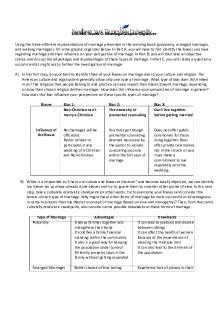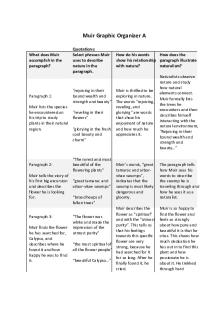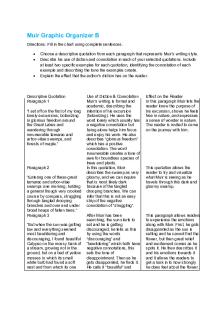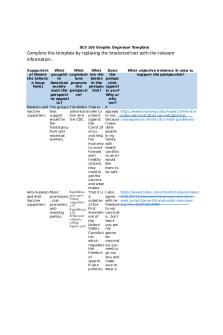3-5 Activity Marriage Graphic Organizer PDF

| Title | 3-5 Activity Marriage Graphic Organizer |
|---|---|
| Author | kim davis |
| Course | Perspectives in the Social Sciences |
| Institution | Southern New Hampshire University |
| Pages | 2 |
| File Size | 92.2 KB |
| File Type | |
| Total Downloads | 64 |
| Total Views | 147 |
Summary
Download 3-5 Activity Marriage Graphic Organizer PDF
Description
SCS 100 Marriage Graphic Organizer Using the three different representations of marriage presented in the module (polyandry, arranged marriages, and walking marriages), fill in the graphic organizer below by replacing the bracketed text with the relevant information. In Part A, you will have to first identify the biases you have regarding marriage and their influence on your perspective of marriage. In Part B, you will then take an objective stance and discuss the advantages and disadvantages of these types of marriage. In Part C, you will create a question a social scientist might ask to further the investigation of marriage. A) In this first step, do your best to identify three of your biases on marriage due to your culture and religion. The American culture and legal system generally allow only one type of marriage. What type of bias does this embed in us? The religions that people belong to and practice can also impact their biases toward marriage, depending on how their chosen religion defines marriage. How does this influence your perspective of marriage in general? How does this bias influence your perspective on these specific types of marriage? Biases
Influence of the Biases B)
C)
Bias 1: Married to only one partner.
Religion, family, legal system
Bias 2: People who marry at a young age are more likely to divorce. Media, statistics
Bias 3: Remain married.
Religion, grandmother
While it is impossible to “check our culture and biases at the door” and become totally objective, we can identify our biases (as you have already done above) and try to ignore them in order to consider other points of view. In this next step, take a culturally relativistic standpoint (in other words, try to overcome your biases) and consider the tenets of each type of marriage. Why might these other forms of marriage be more successful or advantageous in certain contexts than the Western concept of marriage (based on love and monogamy)? Then, from that same culturally relativistic standpoint, also consider some possible drawbacks to these forms of marriage. Type of Marriage Polyandry
Advantages I think the fact that the men help with domestic duties is wonderful. It probably keeps the wife from becoming overwhelmed.
Arranged Marriages
Would save the hassle of dating
Walking Marriages
I can’t really think of any advantages to this kind of marriage. The only thing is that they work to help their own family.
Drawbacks Having multiple husbands is sure to have some major jealousy issues. Having to keep everyone happy is probably near to impossible. Not being happy not liking partner They don’t get to see their kids every day or their wives.
Create a question: In this module, you were given a lot of information about marriage and what marriage means in different cultures. You were also asked to think about what marriage means to you. The next step is to take the information you have been given and create a question a social scientist might ask to further the investigation of marriage. For example, after reading about arranged marriages, you might ask: Are rates of depression higher in women in arranged marriages? Social scientists use existing information to come up with new questions. This is the iterative process of social science research.
Polyandry: How do people in polyandry marriages deal with conflict?...
Similar Free PDFs

Graphic Organizer on Marriage
- 2 Pages

7-5 Activity Graphic Organizer
- 1 Pages

Graphic Organizer
- 3 Pages

SCS 100 Graphic Organizer
- 1 Pages

Wordsworth Graphic Organizer A
- 2 Pages

Amanda Lang Graphic Organizer
- 4 Pages

Graphic Organizer Table
- 6 Pages

Muir Graphic Organizer A
- 2 Pages

Muir Graphic Organizer B
- 2 Pages
Popular Institutions
- Tinajero National High School - Annex
- Politeknik Caltex Riau
- Yokohama City University
- SGT University
- University of Al-Qadisiyah
- Divine Word College of Vigan
- Techniek College Rotterdam
- Universidade de Santiago
- Universiti Teknologi MARA Cawangan Johor Kampus Pasir Gudang
- Poltekkes Kemenkes Yogyakarta
- Baguio City National High School
- Colegio san marcos
- preparatoria uno
- Centro de Bachillerato Tecnológico Industrial y de Servicios No. 107
- Dalian Maritime University
- Quang Trung Secondary School
- Colegio Tecnológico en Informática
- Corporación Regional de Educación Superior
- Grupo CEDVA
- Dar Al Uloom University
- Centro de Estudios Preuniversitarios de la Universidad Nacional de Ingeniería
- 上智大学
- Aakash International School, Nuna Majara
- San Felipe Neri Catholic School
- Kang Chiao International School - New Taipei City
- Misamis Occidental National High School
- Institución Educativa Escuela Normal Juan Ladrilleros
- Kolehiyo ng Pantukan
- Batanes State College
- Instituto Continental
- Sekolah Menengah Kejuruan Kesehatan Kaltara (Tarakan)
- Colegio de La Inmaculada Concepcion - Cebu






